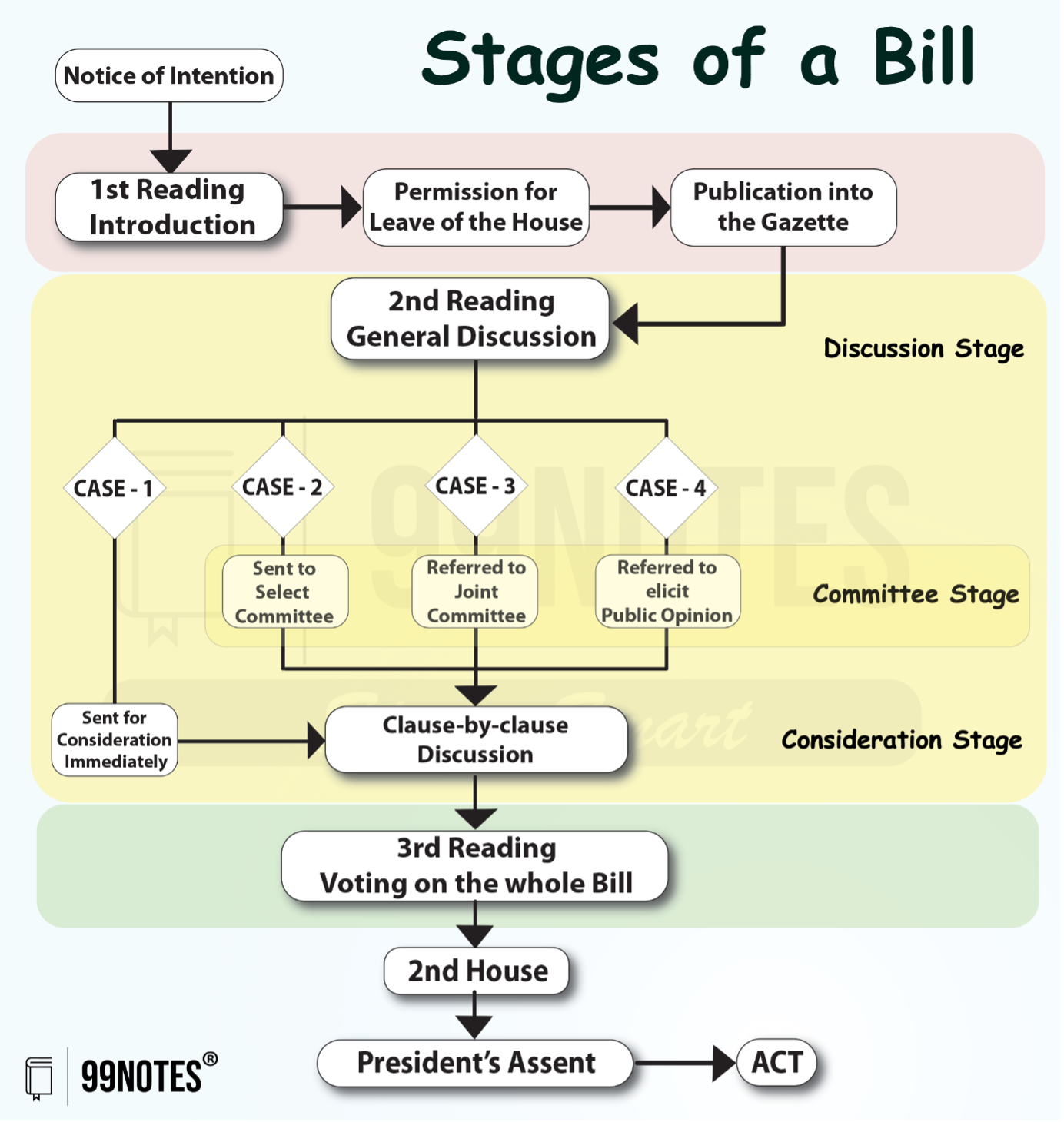Legislative Procedures in the Parliament
Parliament being the supreme legislative body in the country, its primary function is law-making. All legislative proposals in Parliament are brought in the form of bills.
A Bill is a draft statute and cannot become act or law unless it has received the approval of both the Houses and the assent of the President. The process of law-making begins with the introduction of a Bill in either House of Parliament. All stages of legislative processes are the same in both Houses.
A Bill can be introduced either by a Minister or a private member. If a bill is introduced by a minister, it is called a Government Bill, and if it is introduced by a private member, it is known as a Private Member’s Bill.
| Private Bill | Government Bill | |
| Definition | It is introduced by a private member (a member who is not a minister) | Can be introduced only by a minister. |
| Point of View | It usually reflects the stand of opposition parties. | It reflects the legislative agenda of the government. |
| Notice of Intention | Its introduction requires 1-month notice. | “Rules of Procedure” mentions no such requirement. |
| Drafted by | The member who is introducing the bill is responsible for its drafting. | It is drafted by the concerned ministry in consultation with the law department. |
| Significance | Its rejection by the House has no bearing on the confidence in the government. | Its rejection by the House may have implications on the House’s confidence in the ministry. |
Types of bills
The bills introduced in the Parliament can be categorised into four types. The Constitution and the Rules of Procedure have laid down separate procedures for all types of bills.
- Ordinary bills: These can be related to any matters except financial subjects;
- Money bill: These bills are concerned with subjects mentioned in Article 110 of the Constitution, such as taxation, expenditure, etc.
- Financial bills: These are also related to financial subjects, but they are not restricted to subjects mentioned in Article 110.
- Constitution amendment bills: Such types of bills seek to amend, add or remove provisions of the Constitution. We have already read about them in the chapter “Amendment of the Constitution”.
Procedure for Ordinary Bills
A bill has to pass through various stages before it becomes an act. These stages are:
1. First Reading
The legislation starts with the introduction of the bill in either the House of the Parliament.
- Introduction: It can be introduced by either a minister or a private member.
- Leave of the House: Before introducing a bill, a member has to submit a notice of intention asking for the leave of the House. If the leave is granted, the bill stands introduced.
- At this stage, the presiding officer may allow for a brief introductory remark regarding the bill by the member in charge and the member who opposes the motion.
- At this stage, no discussion over the bill takes place.
- However, if the motion to oppose the introduction of the bill is based on the ground that the subject in the bill is beyond the legislative competence of the House, then the Speaker may allow a full discussion.
- Publication in the Official Gazette: After the bill is introduced, it is published in the Official Gazette.
- The bill can be published in the official Gazette even before its introduction in the House if the Presiding officer permits. In such a case, the leave of the House to introduce the bill is not necessary.
- Reference to Standing Committee: At this stage, the presiding officer may refer the bill to a departmentally related standing committee for further examination.
2. Second Reading
- General discussion: At this stage, the general discussion on the bill takes place in which the principles of the bill are discussed. After general discussion, the House may take any of the following actions:
- May consider the bill immediately or on a fixed date;
- Or refer the bill to a select committee;
- Or a joint committee of both houses;
- Or circulate in the public to elicit popular opinion.
- Committee stage: The committee undertakes a thorough examination of the bill clause by clause. It may also suggest amendments but without affecting the underlying principles of the bill. After examining, the bill is sent back to the House.
- Consideration stage: At this stage, the House considers the bill clause by clause and every clause is voted upon. The members may propose amendments to the bill, which, if accepted, becomes part of the bill.

3. Third Reading
At this stage, the bill is finally moved to be passed. This stage does not involve any discussion or amendments. If the majority of the members present and voting approve it, it is considered passed.
After authentication by the presiding officer, the bill is referred to the second House.


![National Human Rights Commission (NHRC) [UPSC Notes] | Updated April 1, 2025 National Human Rights Commission (NHRC) [UPSC Notes]](https://www.99notes.in/wp-content/uploads/2024/01/national-human-rights-commision-featured-667168d64d9c6-768x500.webp)

